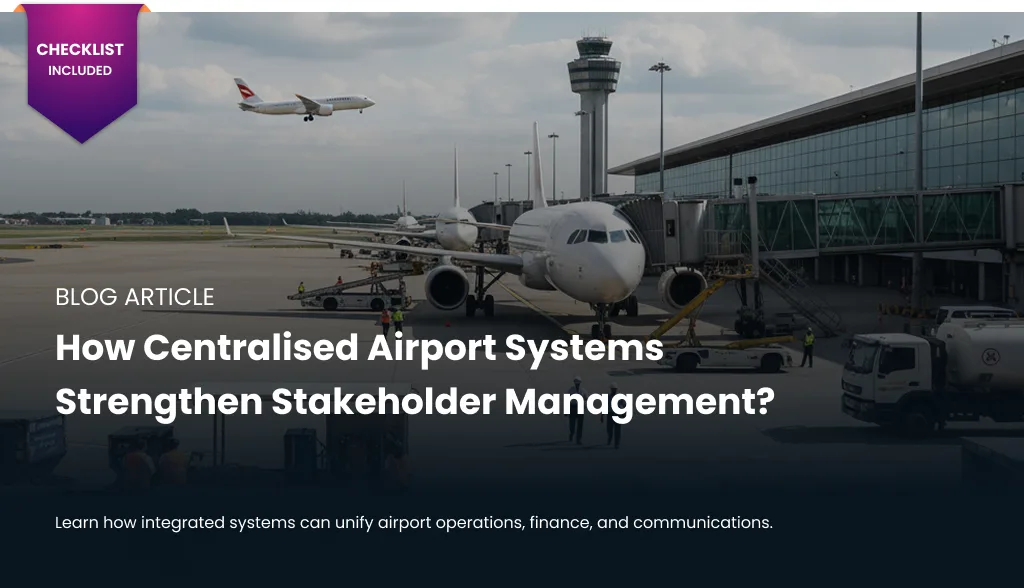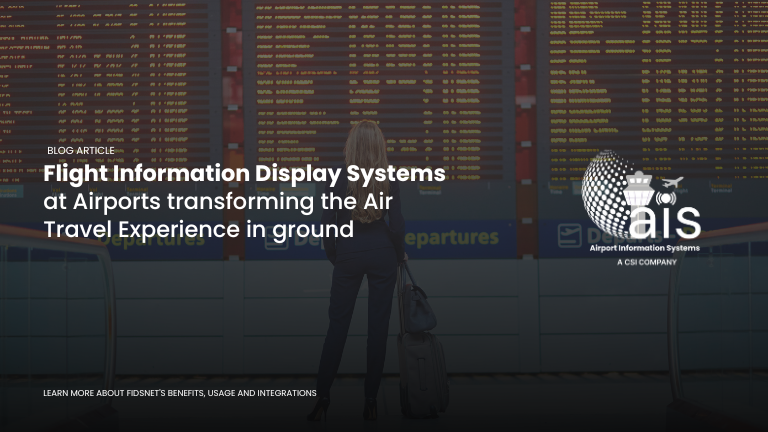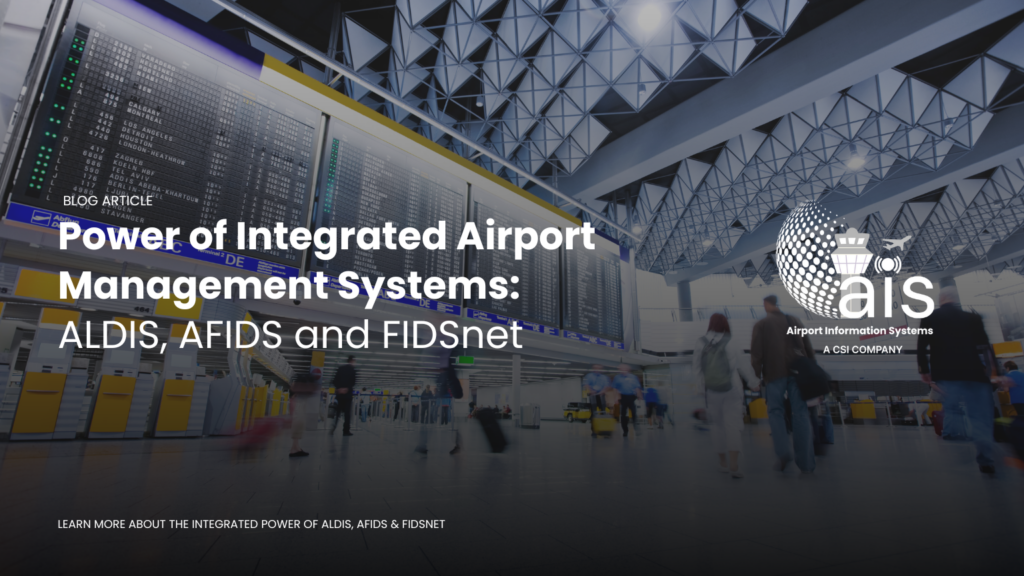- What does Stakeholder Management mean for an Airport today?
- How Centralised Airport Systems Transform Stakeholder Management?
- Centralised Airport Systems: ALDIS, AFIDS, and FIDSnet Integration in Action
- Making the shift: What airport decision-makers should consider while choosing Centralised Airport Systems?
- Conclusion: Moving Forward Together
- FAQs
Running an airport means bringing together dozens of moving parts. But without centralised airport systems, even the best-run airports struggle to keep every stakeholder on the same page. Airlines need gate assignments. Ground handlers require refuelling schedules. Air traffic control sends movement data. Finance teams chase invoices. Passengers want real-time updates. Each group operates with its own systems, priorities, and timelines.
The challenge isn’t just managing these operations; it’s making sure everyone has access to the same accurate information at the same time. When data sits unconnected in separate systems across different departments, gaps appear.
This fragmentation creates real problems. Airlines question billing accuracy when invoice data doesn’t match operational records. Passengers miss connections because stakeholders aren’t coordinating on the same timeline. Revenue leaks through the cracks when services aren’t captured properly. Trust erodes when partners work from different versions of the truth.
The solution lies in bringing operational and financial data together through integrated systems that share information automatically in real-time.
This is where a purpose-built, integrated product suite, such as the one by Airport Information Systems, becomes a decisive asset. With modules covering aeronautical billing (ALDIS), flight and resource systems (AFIDS) and display/communications (FIDSnet), AIS offers a unified platform for operational, commercial and stakeholder-facing functions.
Let’s unpack how centralised airport systems can support stronger stakeholder management: explaining what that means in practice, how to map out the benefits, and what decision-makers should prioritise when evaluating such a suite.
What does Stakeholder Management mean for an Airport today?
When we talk about stakeholder management in the airport domain, we’re talking about more than internal teams. Key stakeholder groups typically include:
- Airlines and handling agents, who expect timely access to apron slots, accurate billing and clear communications.
- Ground-service providers (fuel, security, catering) whose operations depend on real-time coordination.
- Regulatory bodies (air traffic control authorities, customs, border agencies) requiring compliance, data-sharing and auditability.
- Internal teams, operations, finance, and commercial, who each need insights from the same source.
- The passengers themselves, whose experience is influenced by gate changes, delays, display information and partner-service performance.
Each of these groups has its own expectations and dependencies. If your systems are fragmented, one team’s delay becomes another’s headache, and the airline complains, the service provider argues and your reputation takes a dent.
How Centralised Airport Systems Transform Stakeholder Management?
Managing airport stakeholders becomes fundamentally different when everyone works from shared data. The shift isn’t just technical; it changes how partners communicate, coordinate, and trust each other.
Airlines gain Visibility and Confidence
Instead of receiving invoices, they need to verify against their own records; airlines access the same operational database the airport uses for billing. They can check flight details, service usage, and charges before invoices arrive. The system automatically cross-validates data across modules and flags any mismatches, saving time and preventing manual errors.
This interconnected structure eliminates most billing disputes before they start. Airlines also get better planning tools because they can see real-time resource availability, gate assignments, and turnaround status.
Ground handlers operate more efficiently
Integrated systems give ground service providers access to accurate aircraft arrival times, service requirements, and gate assignments as soon as details are confirmed. They can deploy crews and equipment based on actual operational needs rather than estimates. This precision reduces wasted time and improves turnaround performance, benefiting everyone.
Airport operations teams make Faster Decisions
When disruptions such as weather delays, last-minute gate changes and security incidents occur, operations staff need to act quickly. Centralised systems let them see the full picture: which flights are affected, what resources are available, how changes will cascade through the schedule. They can communicate decisions instantly to all stakeholders through the shared platform.
Finance departments Work Smarter, not harder
Automated billing based on integrated operational data means finance teams spend less time on manual calculations and more time on strategic revenue management. They can spot trends, analyse service usage patterns, and make informed decisions about pricing and resource allocation. Audit trails built into the system provide complete transparency for regulators and stakeholders.
Passengers notice the Difference
Behind-the-scenes integration creates visible improvements for travellers. Display screens show accurate, on-time information throughout terminals. Gate changes propagate instantly. Baggage handling systems coordinate better with flight operations. The entire journey feels more controlled and predictable.
The collaborative benefits extend beyond daily operations. Integrated systems make it easier to implement programmes like Airport Collaborative Decision Making, where stakeholders work together to optimise turnaround times and reduce delays. When everyone has access to the same high-quality data, collaborative planning becomes practical rather than aspirational.
Centralised Airport Systems: ALDIS, AFIDS, and FIDSnet Integration in Action
Airport Information Systems demonstrates this integrated approach through three interconnected products that work together as a unified suite.
AFIDS serves as the Operational Foundation
AFIDS is a real-time flight data processing system that collects information from multiple airport departments—air traffic control, handling agents, fuel systems, and ground services. It accepts data in both ICAO and IATA formats, accommodates local time or UTC entry, and captures everything from block times to runway usage to aircraft registrations. The system creates a single, validated operational record for each flight.
ALDIS uses Operational Data for Billing
Rather than requiring separate data entry for invoicing, ALDIS receives flight information directly from AFIDS. It automatically calculates landing fees, parking charges, passenger facility fees, and other aeronautical charges based on predefined rates and agreements. The system handles complex pricing scenarios – discounts for volume commitments, surcharges for peak periods, incentives for new routes, and more. Because billing stems from the same operational records that everyone uses, accuracy improves, and disputes decrease.
FIDSnet delivers information to passengers and staff.
FIDSnet pulls real-time data from AFIDS to show current flight status, gate assignments, and boarding information on screens throughout the terminal. Updates happen automatically as soon as AFIDS processes changes. The system supports multiple languages, customisable layouts, and scheduled content like advertisements or emergency messages. Using modern display technologies, including Android TVs and smart boxes, keeps deployment costs optimised while maintaining reliability.
A Powerful Combination for Real Impact
The integration creates a continuous information flow. Air traffic control logs an aircraft’s arrival. AFIDS processes that data and makes it available across the platform. ALDIS uses the arrival time to calculate parking charges. FIDSnet updates arrival boards throughout the terminal. Ground handlers see the aircraft status in their operational systems. Everyone works from the same information at the same moment.
Airports using this integrated approach report significant improvements. Ireland West Airport Knock automated credit invoicing, reducing manual work and errors. Real-time flight displays kept passengers better informed, improving the travel experience. Resource allocation became more efficient because systems shared data automatically. Financial management improved through accurate invoicing and streamlined billing processes.
The integration extends beyond these three core systems. Operational data can feed other airport applications – security screening, customs processing, retail management, and parking systems. Financial information flows to enterprise resource planning platforms. The centralised database becomes the single source of truth that powers the entire airport operation.
Making the shift: What airport decision-makers should consider while choosing Centralised Airport Systems?
Introducing a new centralised airport system isn’t just a technical upgrade, it’s a strategic decision that affects every stakeholder. From airlines and ground handlers to finance and operations, each team depends on how well your systems communicate and how smoothly data flows between them.
We have drafted a checklist for you that outlines key steps to guide airport leaders through evaluating, selecting, and implementing the right solution for their environment.
Before moving ahead with your next system upgrade, make sure every box is ticked.
Conclusion: Moving Forward Together
Modern airport operations depend on effective stakeholder coordination. Airlines, ground handlers, air traffic control, security services, retail partners, and airport authorities must work together seamlessly to keep flights moving and passengers satisfied.
Centralised airport systems that unify data in a real-time integrated environment make this coordination practical rather than aspirational. When everyone accesses the same accurate, real-time information, trust builds naturally. Disputes decrease because transparency eliminates ambiguity. Operations become more predictable because stakeholders can plan based on verified data rather than estimates.
The technology exists. Airports worldwide have proven that integration delivers measurable benefits – faster billing, better coordination, improved passenger experience, increased revenue streams, and stronger stakeholder relationships. The question isn’t whether integration works but how quickly airports can implement it.
Breaking down information silos isn’t just about technology. It’s about creating an environment where shared data enables shared success. That’s what modern, integrated airport management systems deliver, and why they matter for stakeholder relationships.
A centralised, integrated airport management suite from AIS gives you shared data, transparent interactions and operational control, all of which translate into stronger stakeholder relationships. When airlines, service-providers, regulators and internal teams see the same – trusted numbers and smoother interactions, your credibility rises and your airport performs better.
Interested to know more?


